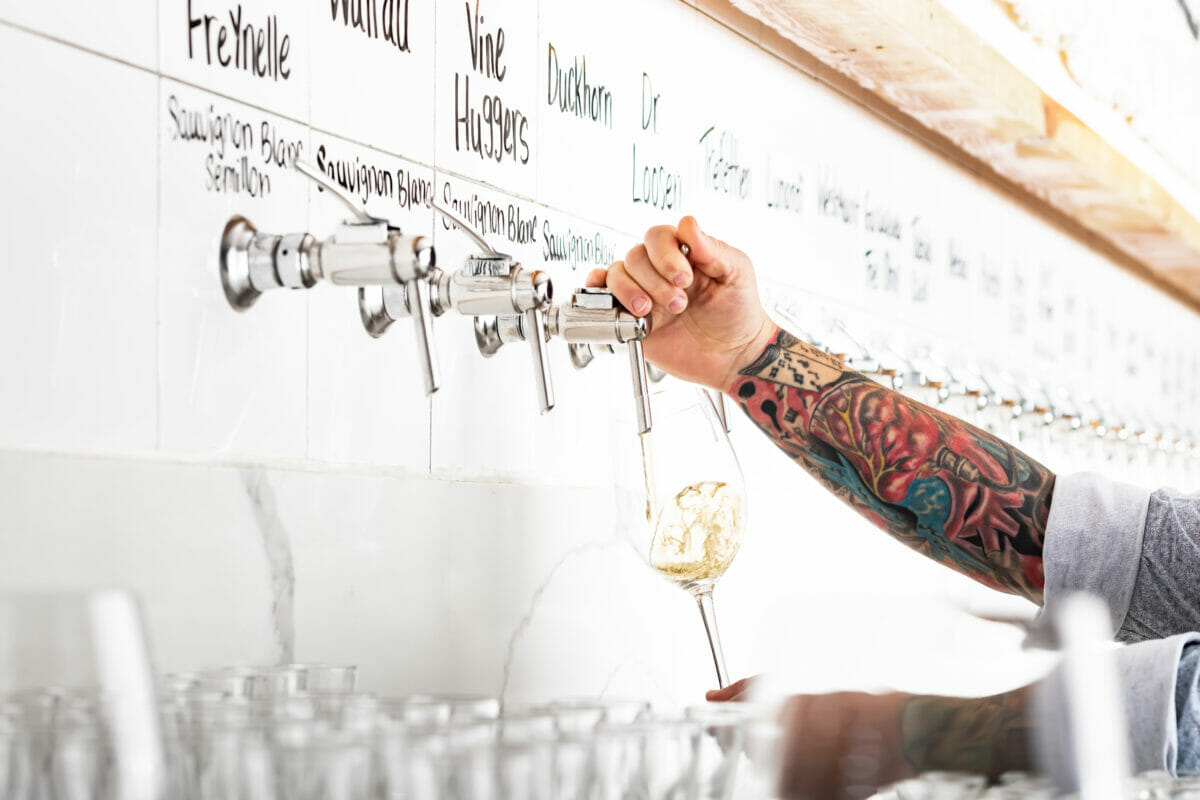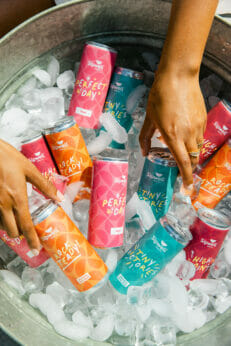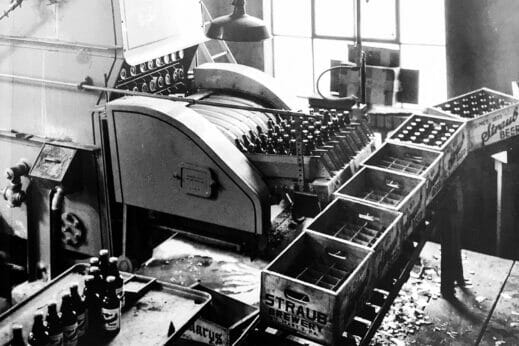Scouting Out Eco-Friendly Drinks in a Sea of Greenwashing
With no official definition for terms like “sustainable” or “natural,” how can you find eco-friendly drink options?
Scouting Out Eco-Friendly Drinks in a Sea of Greenwashing
With no official definition for terms like “sustainable” or “natural,” how can you find eco-friendly drink options?

The wine tap wall at Sixty Vines.courtesy of Sixty Vines.
Taking responsibility for an epidemic of climate disasters is something no individual can or should do, but making more responsible choices in your day-to-day life can have a bigger impact than you might initially believe.
In a recent peer-reviewed analysis published in the journal Science Advances, the authors warn that we have crossed six of nine planetary boundaries—including the atmospheric concentration of carbon dioxide and genetic diversity or the current extinction rate of species—imperiling our ability to live and thrive in functioning societies.
Activists are calling on President Joe Biden to declare a climate emergency and demanding that the companies most responsible for climate change own up and change. But it is becoming increasingly clear that we all have to take personal action, be it reducing our reliance on transportation (the largest source of emissions in the US) to making more sustainable food and drinks choices.
But what does making sustainable drinks choices actually mean? There is no agreed-upon definition of “sustainable”, “eco-friendly”, “green” or “natural”. A bottle of wine declaring itself to be all of these things very well might be—or it might not be.
While the Federal Trade Commission is responding to years of formal complaints and officially taking action on greenwashing and deceptive marketing around sustainability, it’s unclear how ironclad the new rules will be and when they’ll be put into place.
While there are certain third-party certified labels that can clue you into what really went into the growing and production of a bottle of wine, beer or spirits, there are also other clues that will let you know if a producer is authentically sustainable or striking a pose.

Seek out lighter, alternative options
As your mom always tells you, presentation is important. That is why, for decades, bigger and fancier bottles of wine, spirits and beer were used as shorthand for quality. There was no reason beyond aesthetics messaging for still wine producers to put their wares in heavy bottles. (Sparkling wine is a bit different; the built-up pressure of carbon dioxide in sparkling wine can cause lighter bottles to explode). Surely, the thinking went, if this producer can afford to put their wares in a gilded and embossed bottle that requires two hands to lift, it must be good?
But it’s that packaging that is responsible for a shocking proportion of a product’s carbon footprint: an estimated 40 percent for beer, 29 percent for wine and 20 percent for spirits. Thankfully, producers are taking note.
Simply opting for lighter bottles is one option. Bodega Catena Zapata in Argentina is reducing the weight of some of its bottles to 380 from 700 grams starting in 2024, a change that is projected to reduce the carbon emissions of its bottles by an estimated 21 percent, says managing director Laura Catena. This reduction is part of an ongoing effort that will continue in the coming years. Overall as a company, Catena Zapata has already reduced its bottle weight from 2010 through today by 40 percent.
“We are targeting our highest-volume wines first because we know this will make the biggest difference,” says Catena.
How to tell if a bottle of wine is light? Pick it up: 380 grams is about 0.83 pounds, or the same weight as a can of soda.
At Tablas Creek in Paso Robles, CA, which produces around 30,000 cases annually, second-generation proprietor Jason Haas has drastically reduced bottle weights and become one of the first premium US brands to offer wine in boxes.
Haas says the company transitioned to lighter bottles in 2010, as it began farming organically and reducing waste across its production, from grape to glass. Tablas slashed the weight of its bottles almost in half, to 16.5 ounces from 31.5, but was moved to release a limited-edition boxed wine in 2022 after learning that boxes reduce the carbon footprint by 84 percent. While Tablas made 2,000 boxes of wine, or about 650 cases (two percent of the production), Haas calculated that, after just 10 years, it would save 1.37 million pounds of glass. There has been approximately zero blowback from customers on both.
“We got almost universal encouragement on lighter bottles, partly because of the environmental impact, but mostly because the bigger bottles are a pain to lift, handle and store,” says Haas, adding that the $95 boxed wine has also been embraced for its portability and the fact that bag-in-box wine preserves wine for several weeks, making it a great option for people who want just one glass of great wine a day. (And hey, if Vogue thinks boxed wine is cool, maybe projected growth rates of 5.7 percent through 2033 aren’t as off-base as they sound, given wines’ overall declining sales.)
Others are transitioning from bottled beer and wine to cans. The transition from bottles to cans for breweries has been steady and smooth, with brewers saying that cans protect the beer from light, are more recyclable and don’t interfere with flavors. (About 63.4 percent of craft beer on the market is in cans, an enormous increase from five years ago, when just 33.5 percent of craft beer was sold in cans, according to NielsenIQ. After decades of beer in bottles, cans account for a lion’s share of both on- and off-premise beer sales.
Wine and spirits are still distributed primarily in bottle form, but canned cocktail sales are on the rise, and more and more wineries are offering canned wines, with a projected compound annual growth rate through 2028 of 13.2 percent.
“Cans are recycled at about twice the rate of bottles and have a 45-percent lower carbon footprint than bottled wine,” says Hilary Cocalis, founder of Sipwell Wine Company, a California-based canned wine company recognized as the Best Canned Wine of 2022 by Wine Spectator. “Cans also require 60-percent less packaging to ship than the equivalent volume of bottled wine and can be recycled infinitely.”

Start with the stopper
Something as simple as the stopper on a wine or spirits bottle can have an outsize impact on the sustainability of the overall product. Cork is not only biodegradable, it is sourced from living trees in a completely regenerative process for centuries. Cork farmers harvest cork for two months a year from trees that live for up to 250 years, and can be harvested at least 15 times during its lifetime. Trees are harvested every nine years and regenerate between harvests.
“Using a cork stopper has a direct measurable contribution to a better environment,” says Carlos de Jesus, operational director of the Portuguese Cork Association.
Indeed, according to a study conducted by Ernst and Young and commissioned by Corticeira Amorim, one single cork closure captures 309 grams of carbon for still wine and 562 grams for sparkling wine, offsetting the carbon footprint of glass wine bottles, which release between 300 and 500 grams of carbon on average during production. For spirits bottles, cork captures an estimated 148 grams per stopper.
The carbon offset is great, says de Jesus, but the contribution goes deeper.
“In addition to playing a great role in carbon retention, cork oak forests also create well-paid agricultural jobs, foster biodiversity, regulate water cycles and protect against forest fires,” he notes.
Cork closure, check. But also look for extraneous plastic and foil closures around those corks. The capsule on the top of a bottle can look pretty, but it’s a pain to remove and there’s no true need for one. They cost money (which is then passed onto you), the ore from which tin is made is not renewable and foil capsules cannot be recycled in many municipalities. It’s more expensive garbage for the town dump, in other words.
That’s why several producers, including Kings Carey Wines in Lompoc, CA, have opted to go topless.
“The foil costs us about $1 a bottle, so we’ve saved thousands already by opting to go foil-free,” says winemaker James Carey. “We’ve also saved on shipping and prevented needless waste. I know some people like them, but it just entails too much waste to rationalize it. Small steps like that can make big impacts, slowly, but surely, which is why we take action where we can.”

Pennsylvania’s Straub Brewery produces one of—if not the—country’s only reusable beer bottles.
“It used to be that reusable bottles were the only way to go, but they’ve really been completely phased out,” says CEO William Brock. “We stick to it because it makes sense and prevents waste. It also saves resources and money, which we pass on to the consumer.”
The reusable beer bottles Straub offers last up to a decade, and they are about 20 percent cheaper than the throwaways, says Brock. While it accounts for only about 12 percent of Straub’s total production, Brock plans to stick to it for as long as he can.
“Because we’re one of the only breweries still offering this, the bottle-washing machine we use is practically one of a kind at this point,” says Brock. “It requires a little extra effort, but we see it as foundational and part of our mission to just be good corporate citizens.”
One of the sneakiest ways to cut carbon is by snagging wines, ciders and beers by the glass when dining out—from kegs. Kegs, it is estimated, remove about half of all single-use beer containers from bars and restaurants’ waste streams. In the US alone, that accounts for billions of containers. While sipping suds from pints has been one of the preferred ways to consume cider and beers for decades, wine lovers and producers have been slower to embrace the phenomena.
Haas is all in though.
“Just this year we’ve moved to pouring most tasting room wines out of a keg,” says Haas. “We estimate that this saves us from creating about 10,000 bottles a year.”
In addition to eliminating waste and reducing the carbon footprint of wine, because kegged wine maintains its freshness (in bottles, the wine is repeatedly exposed to oxygen, which degrades its quality), it stays good to the last drop.
One restaurant, Sixty Vines, is so bullish on kegged wine that its entire operation revolves around it. Founded in Dallas, TX in 2016, the brand has grown quickly, and it now includes eight restaurants in Texas, Florida, North Carolina, Tennessee and (soon) Virginia. Jeff Carcara, CEO of Sixty Vines, says it launched to “reimagine wine culture” and partner with ultra-premium wine brands such as Charles Heidsieck, Krupp Brothers, Ken Wright and M. Chapoutier not normally—to say the least—associated with keg parties.
They serve an average of 15,000 kegs a year across their restaurants, saving 400,000 bottles of wine a year from the landfill.
“By saving millions of bottles annually and collaborating with renowned winemakers, we champion the environmental benefits of kegged wines,” says Carcara. “Kegs have a 90-percent lower carbon footprint than glass bottles, aligning with our commitment to sustainability. We’re also excited to introduce a younger generation to premium varietals and propel kegging into the mainstream. ”
When it comes to true sustainability, believing what a producer is saying is tempting. But there’s no way to ensure that your interpretation of “eco-friendly” is the same as theirs.
As Carey says, small steps can make big impacts—but only if a lot of us take them. Bottom line: For now, don’t believe everything you read on a drink label.
Follow us
This work is licensed under a Creative Commons Attribution-NoDerivatives 4.0 International License.
Want to republish a Modern Farmer story?
We are happy for Modern Farmer stories to be shared, and encourage you to republish our articles for your audience. When doing so, we ask that you follow these guidelines:
Please credit us and our writers
For the author byline, please use “Author Name, Modern Farmer.” At the top of our stories, if on the web, please include this text and link: “This story was originally published by Modern Farmer.”
Please make sure to include a link back to either our home page or the article URL.
At the bottom of the story, please include the following text:
“Modern Farmer is a nonprofit initiative dedicated to raising awareness and catalyzing action at the intersection of food, agriculture, and society. Read more at <link>Modern Farmer</link>.”
Use our widget
We’d like to be able to track our stories, so we ask that if you republish our content, you do so using our widget (located on the left hand side of the article). The HTML code has a built-in tracker that tells us the data and domain where the story was published, as well as view counts.
Check the image requirements
It’s your responsibility to confirm you're licensed to republish images in our articles. Some images, such as those from commercial providers, don't allow their images to be republished without permission or payment. Copyright terms are generally listed in the image caption and attribution. You are welcome to omit our images or substitute with your own. Charts and interactive graphics follow the same rules.
Don’t change too much. Or, ask us first.
Articles must be republished in their entirety. It’s okay to change references to time (“today” to “yesterday”) or location (“Iowa City, IA” to “here”). But please keep everything else the same.
If you feel strongly that a more material edit needs to be made, get in touch with us at [email protected]. We’re happy to discuss it with the original author, but we must have prior approval for changes before publication.
Special cases
Extracts. You may run the first few lines or paragraphs of the article and then say: “Read the full article at Modern Farmer” with a link back to the original article.
Quotes. You may quote authors provided you include a link back to the article URL.
Translations. These require writer approval. To inquire about translation of a Modern Farmer article, contact us at [email protected]
Signed consent / copyright release forms. These are not required, provided you are following these guidelines.
Print. Articles can be republished in print under these same rules, with the exception that you do not need to include the links.
Tag us
When sharing the story on social media, please tag us using the following: - Twitter (@ModFarm) - Facebook (@ModernFarmerMedia) - Instagram (@modfarm)
Use our content respectfully
Modern Farmer is a nonprofit and as such we share our content for free and in good faith in order to reach new audiences. Respectfully,
No selling ads against our stories. It’s okay to put our stories on pages with ads.
Don’t republish our material wholesale, or automatically; you need to select stories to be republished individually.
You have no rights to sell, license, syndicate, or otherwise represent yourself as the authorized owner of our material to any third parties. This means that you cannot actively publish or submit our work for syndication to third party platforms or apps like Apple News or Google News. We understand that publishers cannot fully control when certain third parties automatically summarize or crawl content from publishers’ own sites.
Keep in touch
We want to hear from you if you love Modern Farmer content, have a collaboration idea, or anything else to share. As a nonprofit outlet, we work in service of our community and are always open to comments, feedback, and ideas. Contact us at [email protected].by Kathleen Willcox, Modern Farmer
October 25, 2023
Modern Farmer Weekly
Solutions Hub
Innovations, ideas and inspiration. Actionable solutions for a resilient food system.
ExploreShare With Us
We want to hear from Modern Farmer readers who have thoughtful commentary, actionable solutions, or helpful ideas to share.
SubmitNecessary cookies are absolutely essential for the website to function properly. This category only includes cookies that ensures basic functionalities and security features of the website. These cookies do not store any personal information.
Any cookies that may not be particularly necessary for the website to function and are used specifically to collect user personal data via analytics, ads, other embedded contents are termed as non-necessary cookies.
Good article – anything we can do to reduce our impacts on the environment is a benefit to all.
Stop deforestation for vineyard development.
Wow, great information. I always thought buying in glass was a better way to go since glass is recyclable. Thanks for writing this article.
The brains of autopsied dementia victims have long been known to contain aluminum deposits. Alcohol is a known solvent. The acid of wine is a solvent. Perhaps glass has aluminum content, but it certainly is less, and probably in a more stable form than an aluminum can. I know of no one (even those who prefer cans for the weight convenience) who doesn’t think bottled beer is less taste compromised by the container than cans. Are there studies on the migration of contaminants from cans vs glass over time? Another point, re spirits. Regulatory agencies need to get beyond the… Read more »
Note that the way that spirits (whiskey, gin, etc.) can be packaged and delivered to consumers is strictly dictated by the federal government. Distilleries are not allowed to re-use bottles or sell spirits in anything other than glass bottles. It would be great to see spirits be allowed to be sold in reusable containers, or to bars and restaurants in larger containers (1.5L glass bottles are currently the largest allowed).